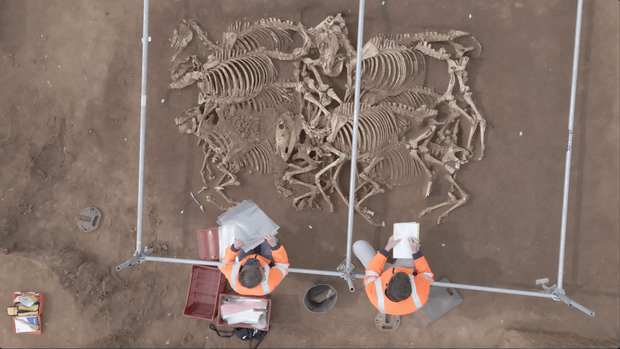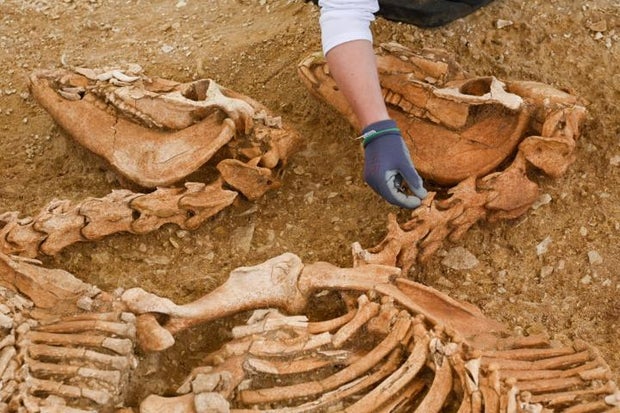CBS News
Ancient remains of 28 horses found in France. Were they killed in battle or sacrificed?

An archaeological dig in France uncovered over two dozen dead horses and left researchers with a puzzling mystery.
The excavation, located in Villedieu-sur-Indre in Central France, uncovered several buildings, pits, ditches and even a pathway from the early Middle Ages, according to a news release from the country’s National Institute for Preventive Archaeological Research. The finds included nine pits containing the remains of horses.
Archaeologists used radiocarbon dating to determine that the horses lived between 100 BC to 100 AD, a span of about 200 years.
Just two of the pits have been fully excavated so far. In one pit, the horses were all found lying on their right sides, with their heads to the south, according to the news release. The animals were “carefully placed in the pit and organized in two rows and on two levels,” and evidence shows that the horses were “buried simultaneously, very quickly after their death.” All the horses were small males, over four years old and likely Gallic livestock.
François Goulin, INRAP
The second pit contains just two horses, but they were buried the same way as the others.
Another pit was found to contain two adult dogs, positioned and “carefully placed” in the same fashion, the news statement said, but researchers don’t know what — if anything – the canine inclusion signifies. While other pits have yet to be excavated fully, researchers have found remains of bones that have allowed them to identify at least 28 horses buried in the site.
The precision and uniformity of the burial sites have left researchers wondering how and why the animals died. According to the news release, illnesses can be ruled out since there are no young or female horses among the dead, leaving just two likely options: the horses may have fallen in battle and been buried with honors, or they may have been sacrificed.
Hamid Azmoun, INRAP
Similar discoveries have been made at other Gallic battle sites in France. One had a pit that held eight riders and their horses, while another site had 53 horses buried across five pits. The sites are close to battlefields in the region, making it possible that they were killed in those battles and buried, according to the news release.
Little information was given as to why the animals might have been sacrificed, with the news release noting that the death of 28 horses was a “massive drain on the heart of a herd.”
Researchers are continuing to study the pits and other structures at the site to try and answer how and why the animals died and what else the site may have been used for.
CBS News
Here Comes the Sun: Jack Antonoff and more

Watch CBS News
Be the first to know
Get browser notifications for breaking news, live events, and exclusive reporting.
CBS News
Capturing Moriah Wilson’s Killer – CBS News

Watch CBS News
Be the first to know
Get browser notifications for breaking news, live events, and exclusive reporting.
CBS News
How to watch the Minnesota Vikings vs. Chicago Bears NFL game today: Livestream options, more

Getty Images
The Minnesota Vikings will take on the Chicago Bears today. The Vikings are currently 8-2, an impressive run so far this season, and will be looking to add a fourth win to their current streak after last Sunday’s 23-13 win against the Tennessee Titans. The Bears, on the other hand, are entering this game on the heels of a four-game losing streak after a tough 20-19 loss against the Green Bay Packers last Sunday.
Here’s how and when you can watch the Vikings vs. Bears game today, whether or not you have cable.
How and when to watch the Minnesota Vikings vs. Chicago Bears
The Vikings vs. Bears game will be played on Sunday, November 24, 2024 at 1:00 p.m. ET (11:00 a.m. PT). The game will air on Fox and stream on Fubo and the platforms featured below.
How and when to watch the Minnesota Vikings vs. Chicago Bears game without cable
You can watch this week’s NFL game on Fox via several streaming services. All you need is an internet connection and one of the top options outlined below.
Fubo offers you an easy, user-friendly way to watch NFL games on CBS, Fox, NBC, ABC, ESPN, and NFL Network, plus NCAA football channels. The Pro tier includes 200+ channels and unlimited DVR, while the Elite with Sports Plus tier adds NFL RedZone and 4K resolution. New subscribers get a seven-day free trial and all plans allow streaming on up to 10 screens simultaneously.
You can watch today’s game with a subscription to Sling’s Orange + Blue tier, which includes ESPN, ABC, NBC, and Fox. The plan offers 46 channels with local NFL games, nationally broadcast games and 50 hours of DVR storage. For complete NFL coverage, add Paramount+ to get CBS games, or upgrade with the Sports Extra add-on for additional sports channels like Golf Channel, NBA TV and NFL RedZone.
Watching NFL games, including Fox broadcasts, is simple with Hulu + Live TV, which includes 90 channels, unlimited DVR storage, and access to NFL preseason games, live regular season games and studio shows. The service includes ESPN+ and Disney+ in the subscription.
Want to watch today’s game live on your smartphone? If so, NFL+ streaming service is the solution you’re looking for. It lets you watch NFL Network and out-of-market games on mobile devices, with an upgrade option to NFL+ Premium that includes NFL RedZone for watching up to eight games simultaneously. Note that NFL+ only works on phones and tablets, not TVs.










